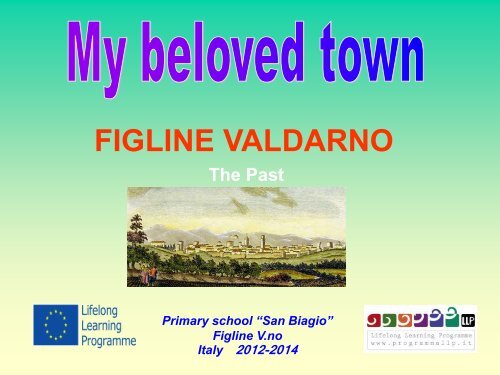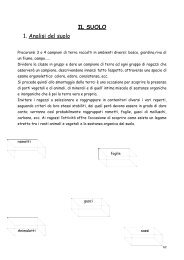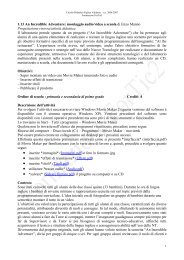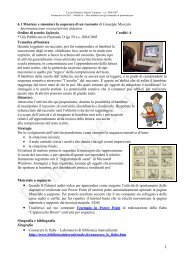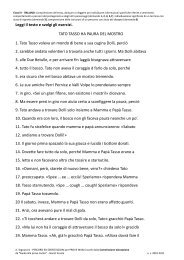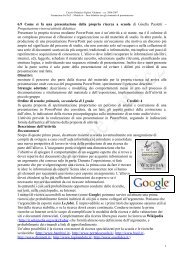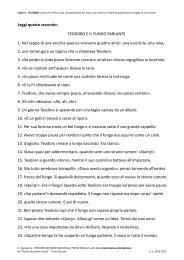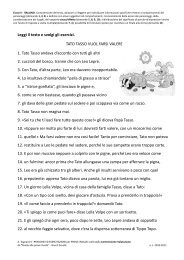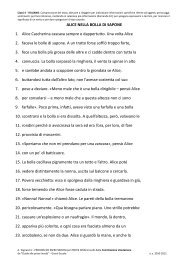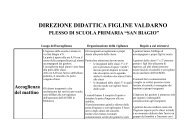il mio amato paese my beloved town - Circolo Didattico Figline ...
il mio amato paese my beloved town - Circolo Didattico Figline ...
il mio amato paese my beloved town - Circolo Didattico Figline ...
You also want an ePaper? Increase the reach of your titles
YUMPU automatically turns print PDFs into web optimized ePapers that Google loves.
FIGLINE VALDARNO<br />
The Past<br />
Primary school “San Biagio”<br />
<strong>Figline</strong> V.no<br />
Italy 2012-2014
FIGLINE OR “FIGULINAE”<br />
The name “<strong>Figline</strong>” derives from the Latin "figulinae"<br />
transformed over time into "<strong>Figline</strong>" which means "art of the<br />
potter" In fact, the clay so<strong>il</strong> allowed the manufacture of vases and<br />
terracotta tableware.<br />
Nel medioevo <strong>il</strong><br />
nome diventa<br />
“FEGGHINE”
INFORMATION ABOUT FIGLINE<br />
The first mention of the castle of<br />
"Fegghine " dates back to 1000 AD<br />
This castle was found on a h<strong>il</strong>l in the<br />
area of the San Romolo.<br />
The inhabitants descended regulary<br />
in the valley and founded the great<br />
"forum of <strong>Figline</strong>", a kind of market.<br />
Over the years, the population<br />
increased and it became a small<br />
<strong>town</strong>.<br />
"ceramic plate"
Our <strong>town</strong> walls<br />
The walls surrounding the <strong>town</strong> of <strong>Figline</strong> data back to 1300<br />
The wall was 1,700 meters long and there were 19 - 20<br />
battle towers
There were four gates to get into and out of<br />
<strong>Figline</strong> : porta Fiorentina to the North, Porta<br />
Aretina souh of the square, in the west Porta<br />
Senese and in the east Porta San Francesco.<br />
Map of the ancient walls
A good part of this wall with towers can<br />
st<strong>il</strong>l be seen, but the gates were<br />
destroyed
Today the only gate existing is Porta<br />
Senese<br />
Porta<br />
Senese<br />
Porta<br />
Aretina<br />
Porta<br />
Fiorentina<br />
Porta San<br />
Francesco
WHO PAID FOR THE WALLS?<br />
The construction of the walls of <strong>Figline</strong> were<br />
paid by the citizens with money derived from<br />
local taxes (called " Gabelle").
The "Praetorian<br />
Palace" is<br />
located in<br />
Piazza Bianchi.<br />
It is a bu<strong>il</strong>ding<br />
dating from the<br />
fourteenth<br />
century and<br />
later restored by<br />
the architect<br />
Enzo Cerpi.<br />
Il Palazzo Pretorio
Outside the bu<strong>il</strong>ding,<br />
there are various<br />
coats of arms of the<br />
old mayor.<br />
The bu<strong>il</strong>ding is<br />
completely made of<br />
stone adorned with<br />
Guelf battlements.<br />
The bell, now located in<br />
the entrance hall, was<br />
once on top of the<br />
tower
THE BELL<br />
The bell, which dates back<br />
to 1384, was a war booty<br />
which celebrates the<br />
defeat of the Ghibellines.<br />
On the bell we can read: "to<br />
perpetuam destructionem<br />
et mortem totius partis<br />
Ghibelline" (for the eternal<br />
destruction of all<br />
Ghibellines.)
During the 19th century,<br />
the bu<strong>il</strong>ding was turned<br />
into a prison. There is<br />
also a chapel dedicated<br />
to war victims. Inside<br />
there is a beautiful<br />
enamel terracotta base<br />
-relief of the Madonna<br />
and Ch<strong>il</strong>d
LA COLLEGIATA DI SANTA<br />
MARIA<br />
The church of<br />
"Santa Maria"<br />
called<br />
"Collegiata"<br />
was bu<strong>il</strong>t in<br />
1252 and<br />
was<br />
consecrated<br />
in 1257.
The church stands on the site of an ancient<br />
church dedicated to Our Lady
The facade, of the<br />
1600, is like a hut<br />
with a central<br />
marble portal.<br />
Above the door<br />
there is a circular<br />
rose window.<br />
At the top, the<br />
construction has<br />
a triangular<br />
pediment<br />
Deta<strong>il</strong> of the<br />
main entrance
INSIDE COLLEGIATA<br />
The nave is covered<br />
by wooden beams.<br />
There are four tall<br />
windows called<br />
"monofore " that<br />
provide light inside.<br />
The main altar is<br />
made of marble,<br />
with a large<br />
wooden crucifix.
SAN FRANCESCO CHURCH<br />
San Francesco church<br />
is located in <strong>Figline</strong><br />
Valdarno in Piazza<br />
San Francesco<br />
The church was bu<strong>il</strong>t<br />
between the late<br />
12th and early<br />
14th(1200-1300)<br />
century<br />
The architectural style is"Gothic - Renaissance"<br />
In front there is a portico, the facade has two<br />
types of stone: GREEN MARBLE and LIGHT<br />
STONE .
Inside there are some" frescos"<br />
‣ LA CROCIFISSIONE E I SANTI di Francesco d’Antonio<br />
(1418 circa)<br />
‣ LA MADONNA CHE DONA LA CINTOLA A S. TOMMASO<br />
‣ CRISTO IN PIETA’ FRA I SANTI<br />
BARTOLOMEO,FRANCESCO, LUDOVICO DI TOLOSA E<br />
IACOPO
GARIBALDI THEATRE<br />
The theatre was<br />
bu<strong>il</strong>t by the<br />
'Academia dei<br />
Ristori " based<br />
on the project of<br />
architect Angelo<br />
Pierallini.<br />
It is located behind<br />
the walls of<br />
<strong>Figline</strong> Valdarno<br />
near Porta<br />
Fiorentina
The opera "Ernani" by Giuseppe Verdi opened the<br />
theatre in the spring of 1871<br />
Inside<br />
The theatre was seriously damaged during the<br />
World Wars
• The <strong>town</strong> hall bought the<br />
theatre in 1973 and started<br />
its renovation in 1985<br />
• The theatre was inaugurated<br />
in 1995 with the season of<br />
prose, plays and classical<br />
music.
"Spedale dell’Annunziata"<br />
The " Old<br />
Hospice of Lady<br />
of the<br />
Annunciation"is<br />
located in Piazza<br />
Mars<strong>il</strong>io Ficino<br />
It was founded in<br />
the late sixteenth<br />
century by the<br />
nobleman "Ser<br />
Ristoro"
Originally it was a shelter for p<strong>il</strong>grims and<br />
beggars<br />
In 1600 it was transformed into a real<br />
hospital
In 1890 the Serristori fam<strong>il</strong>y moved the<br />
hospital to V<strong>il</strong>la San Cerbone<br />
The premises were transformed in to small<br />
residential homes.<br />
Today, under the portico there are bars,<br />
shops and a small chapel
VILLA SAN CERBONE –<br />
SPEDALE SERRISTORI<br />
The "v<strong>il</strong>la of San<br />
Cerbone" dates<br />
from the<br />
fourteenth<br />
century.<br />
Mr. Serristori in<br />
1890 decided<br />
to make it the<br />
new location for<br />
the "Hospital"
At the hospital, you can visit the interesting<br />
ancient apothecary. Here there are many<br />
collections of ampoules, ceramic vases and<br />
antique books
The ghost hospital<br />
In this hospital there is also a ghost .....<br />
The ghost of a brunette woman who<br />
wanders the corridors with a knife in her<br />
hand looking for her husband's lover.<br />
Her name is Veronica Cybo
The logge of the<br />
internal courtyard<br />
External view of<br />
hospital
Old photos<br />
Palazzo pretorio<br />
Teatro Garibaldi<br />
Chiesa San Francesco<br />
Piazza Mars<strong>il</strong>io Ficino
ANCIENT PAINTERS<br />
Giovanni<br />
di Papino<br />
Calderini<br />
This painter was<br />
born in 1499, the<br />
most famous<br />
painting is<br />
"Madonna and<br />
Ch<strong>il</strong>d" exposed in<br />
the sanctuary of<br />
Santa Maria a<br />
Ponterosso
Maestro di <strong>Figline</strong><br />
" Maestro di <strong>Figline</strong>"<br />
is an anonymous<br />
artist of the fourteenth<br />
century:<br />
The title "Maestro di<br />
<strong>Figline</strong>" is derived<br />
from an altarpiece<br />
with the Virgin and<br />
Ch<strong>il</strong>d preserved in<br />
Collegiate church of<br />
<strong>Figline</strong><br />
Madonna in trono col Bambino<br />
fra San Ludovico di Tolosa e<br />
Sant'Elisabetta di Ungheria
The painter was<br />
born in <strong>Figline</strong><br />
Valdarno in 1837<br />
and died in<br />
Florence in 1901.<br />
One of his greatest<br />
historical works is<br />
exposed in the<br />
Uffizi in Florence.<br />
"Corradino di<br />
Svevia"<br />
Egisto Sarri


